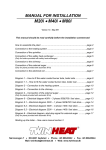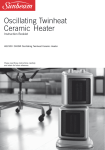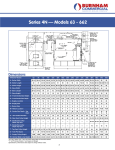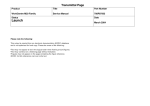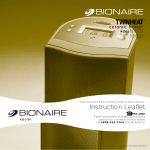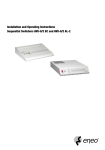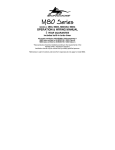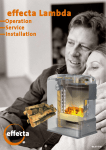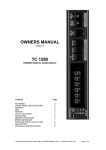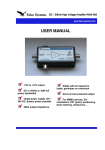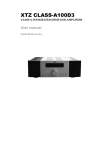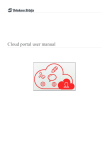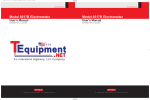Download Diagram 2 - TwinHeat
Transcript
MANUAL FOR INSTALLATION ME20i ME40i ME80i Version 1.3 – May 2011 This manual should be read carefully before the installation commences! How to assemble the plant .............................................................................page 2 Connection to the heating system ..................................................................page 3 Connection of the sprinkler.............................................................................page 4 Connection of the safety heat exchanger .......................................................page 5 (Only for boilers provided with safety heat exchanger) Connection to the chimney .............................................................................page 5 Connection of the external auger ...................................................................page 6 Connection to the electrical net ......................................................................page 6 Diagram 1 – How to fit the water cooled burner tube, (side) ..........................page 7 Diagram 1.1 – How to fit the water cooled burner tube, (rear)........................page 8 Diagram 2 – Connection to the heating system..............................................page 9 Diagram 3 – Connection to the chimney ......................................................page 10 Diagram 4 – Connection of the external auger .............................................page 11 Diagram 5 – Electrical diagram 400V – 3 phase ..........................................page 12 Diagram 5.1 – Electrical diagram 230V – 1 phase .......................................page 13 Diagram 6 – Electrical diagram, start-stop signal for external auger ...........page 14 Starting up the boiler – See users manual section 2 Nørrevangen 7 DK-9631 Gedsted Phone +45 98645222 Fax. +45 98645244 Mail: [email protected] Web: www.twinheat.dk 2 The installation of this plant must be made in accordance with the local rules and regulations on the place of installation Before the plant is placed on its final place it should be inspected carefully for transport damages. Possible damages should be reported to the forwarder. How to assemble the plant The plant is delivered on 2 Euro pallets and consists of a boiler, a stoker and a burner tube which must be assembled before installation. 1. The water cooled burner tube is fixed on the stoker unit by means of bolts included. The gasket plus bolts for the fixation are included. 2. The stoker unit with the now fitted burner tube is pushed into the pre made hole with flange in the boiler. 3. Before you fixate the stoker and burner tube to the boiler (with 2 bolts) you must adjust the height of the stoker by means of 2 adjustment screws on the leg, that it is placed horizontal and in a 90 º angle to the boiler. It is absolutely important, that the water cooled burner tube is horizontals as you otherwise might experience air pockets in the system. 4. The water cooling of the burner tube can now be installed as shown on diagram 1 and diagram 1.1 All parts included fittings and circulation pump are in the accessories box included. (Please note, that the circulation pump is for circulation between boiler and burner tube only) 5. The combustion fan is fitted on the square stud of the burner tube, no gasket needed. 6. The hose for pressure equalising in the stoker is fitted on the stud on the burner tube 7. The draft regulator, needed by manual heating, is fixed on the top of the boiler in the same side as the door hinges for the combustion room door. The chain is connected to the lower air inlet on the boiler. 8. The plug for power to the boiler is pushed in and secured by a screw. The cable is placed in the tray underneath the plug. Cable W7 is for circulation pump. INSTALLATION 3 The sketch indicates the recommended minimum distances in the boiler room. According to Danish fire rules the room must be equipped with a ½ to ¾ inch high pressure water tap and a ventilation opening, either as a window or as a ventilation grill B A B A D C C Recommended minimum distances in the boiler room (the stoker is placed at the right ore left side of the boiler) Recommended minimum distances in the boiler room (the stoker is placed at the rear side of the boiler) Measures in cm Measures in cm A B C A B C D ME 20i 7 20 120 ME 20i 12 20 120 80 ME 40i 10 20 160 ME 40i 12 20 160 80 ME 80i 10 20 160 ME 80i 10 20 160 80 Connection to the heating system See diagram 2 The boiler must be connected as shown in diagram 2 or as demanded by local statutes. Further information is in the manual, section. 7 The minimum amount of water passing through the boiler must be (see table) Plant type ME 20i ME 40i ME 80i Nom. effect [kW] 29 48 80 Min. Amount of water [m³/h] 2,5 4,1 6,9 Water returning to the boiler must always be min. 60°C If the above is not adhered to you will risk increased tear of the steel in the boiler, resulting in a shorter life expectation for the plant. INSTALLATION 4 According to Danish laws and regulations this boiler must be connected to a system with “open” expansion tank. Please check you local regulations General The expansion tank must be able to contain at least 4 % of the total amount of water in the heating system. Should the plant be installed with an accumulation tank, then the expansion tank must be able to contain at least 8 % of the total amount of water in the heating system. The boiler must be in non blockage connection to the expansion tank (You must not be able to block the pipe between) Should the open expansion tank be placed in a not frost safe place, that tank itself must be protected against frost. The circulation to the tank may be controlled by a thermostatic valve or similar in order to secure, that the boiler water is getting minimum access to oxygen. Connection of the sprinkler The sprinkler system for the boiler must be under constant water pressure from a ½ inch tap with a safety faucet and be connected to the dirt collector under the pressure tank. Please make sure, that pipes / hoses are free of dirt or metal shavings. You must test the system, when it has come under pressure. The easiest way to test the sprinkler system is to unscrew the hose from the thermostatic valve to the auger channel. Then press the red cap under the valve to activate it After testing the sprinkler system it is important to check that the valve is closing properly! (Dirt ore the like, in the valve seat, can prevent this) INSTALLATION 5 Connection of the safety heat exchanger (Quenching coil) (Only for boilers provided with safety heat exchanger) The boiler has a build-in safety heat exchanger which cools the boiler in case of pump failure or the like. The system will be activated if the water temperature in the boiler exceeds 95°C. Drain from quenching coil Supply cold water for quenching coil Thermal safety valve - 95°C Temperature sensor for thermal safety valve The thermal safety valve must be connected to constant water pressure from a G¾”/22mm pipe. The water pressure must be minimum 2 bar and the temperature maximum 15°C There must be no shutoff valves on the pipe supplying the valve. Flush the pipes before connecting to the thermal safety valve. Dirt or metal shavings can cause the valve to malfunction. The return drain from the safety heat exchanger G¾” must be connected to a drain. The pipe used to connect to the drain must have a sufficient size to avoid the emergence of backpressure. After installation the system must be tested to ensure free passage trough the safety heat exchanger. The thermal safety valve can be manually activated by pressing the red cap. Connection to the chimney See diagram 3 Further information is in the user manual, section. 7 In order to get a good heating economy and to avoid smoke problems you must connect the boiler to a suitable chimney. The boiler should be placed as close to the chimney as possible. Should the chimney be too unsuitable or under difficult draft conditions you might have to install a flue fan. It is in general recommended to install a draft stabilizer (See diagram 3) A chimney with unstable draft can case unstable running conditions of the plant. INSTALLATION 6 It is important that the flue pipe is insulated with a 30mm fire resistant mat, to avoid that the flue gasses are condensing in it. Recommended chimney dimensions. Plant type M20i M40i M80i Max. effect, input 34 kW. 55 kW. 92 kW. Flue outlet on boiler Ø 155 mm Ø 187 mm Ø 215 mm Free opening in chimney Ø 160-180 mm Ø 180-200 mm Ø 200-250 mm Height of chimney 5-6 metre 5-8 metre 6-8 metre Connection of the external auger See diagram no 4 The connection must be made with a flexible hose. The auger must not support on the stoker unit and vibrations from the auger must not be transmitted to the stoker unit. In case the plant is connected to a silo placed at the loft above you should also use a flexible hose, which must be emptied after each filling. The hole through the ceiling must be made fire-proof. Connection to the electrical net See diagram no 5 / 5.1 The boiler can be built for either 400V 3 phase or 230V single phase connection. Check boiler data plate for electrical connection. In Denmark the installation must be made by an authorised electrician. Here too we ask you to check your local regulations Electrical supply for the stoker plant: There should be specific switch for this plant only Electrical supply for the internal circulation pump: The internal circulation pump (placed under the burner tube) is to be connected to cable no. W7 The pump must not be started before filled with water, as this might damage it. Setting of the internal circulation pump: The pump must be set to run in a fixed step. It must not run in Auto mode! Boiler ME20i ME40i ME80i Pump step I I II Connection of start – stop signal for external auger: See diagram no 6 The motor protection relay (contact) for the external auger must be supplied with a start – stop signal from the controlling unit of the plant, which is placed in a plastic box at the side of the fuel valve, on the rear of the stoker. INSTALLATION 7 Diagram 1 - How to fit the water cooled burner tube by plants with stoker placed at the side of the boiler (No gasket) Draft regulator Connection for sprinkler Supply boiler Hose for pressure equalising pipe Stoker unit Boiler Burner tube Included fittings 2 pcs. 3/4" Hose 1 pcs. 3/4" Safety valve 2 pcs. 3/4" Shutoff valve 1 pcs. 1/2" Shutoff valve 1 pcs. Cirkulation pump 5 pcs 3/4" Hexagon nipple 1 pcs. 3/4"x 3/4"x 1/2" Tee 1 pcs. 1"x 3/4" Hexagon nipple 1 pcs. 3/4" Tee 2 pcs. 3/4" Elbow 2 pcs. 3/4" Union joint, for pump Elbows and valves are to be placed horizontal, to avoid airpockets in the hoses! By M40 is included a 3/4" connection sleeve ! DIAGRAM 1 8 Diagram 1.1 - How to fit the water cooled burner tube by plants with stoker placed at the rear end of the boiler (No gasket) Draft regulator Connection for sprinkler Supply boiler Hose for pressure equalising pipe Stoker unit Boiler Burner tube Included fittings 2 pcs. ¾" hose 1 pcs. ¾" safety valve 1 pcs. cirkulation pump 2 pcs. ¾" union joint, for pump 2 pcs. ¾" shutoff valve 1 pcs. ½" shutoff valve 5 pcs. ¾" hexagon nipple ME20: ¾" x 1" hexagon nipple 1 pcs. ¾" tee ME40: ¾" x 1½" hexagon nipple 1 pcs. ¾" x ¾" x ½" tee ME80: ¾" x 2" connection nipple + ¾" hexagon nipple 1 pcs. ¾" plug DIAGRAM 1.1 9 Diagram 2 – Connection to the heating system Open expansion vessel EÅ shutoff valve V1-V2 shutoff valves on supply and return, in the boiler room. More can be installed if needed. V3 Boiler shunt valve secure that the return water to the boiler always is over 60°C. V4 To protect open expansion vessel against frost Can be thermostatic return valve Airing V5 Airing, possible automatic, placed where needed. Thermometer T1-T4 Thermometer for supply, water return before and after shunt valve and for flue temperature Temperature sensor TF1 Temperature sensor to regulate shunt valve. Manometer M1 Manometer for boiler pressure. Pump P1 Circulation pump for heating system 3 way thermostat controlled mixing valve (shunt valve) Manuel regulation valve (return valve) DIAGRAM 2 10 Diagram 3 – Connection to the chimney * Prefabricated module chimneys should not be placed on top of the flue outlet, as this allows rainwater or possible condense water to run directly down into the heat exchanger of the boiler, where it will cause corrosion ! Brick-build or block-build chimney Brick-build or block-build chimney Insulation Elbow with clean out hole Draft stabilizer mounted in chimney Draft stabilizer mounted on flue pipe Clean out Clean out *Module chimney with steel or ceramic liners *Module chimney with steel or ceramic liners Insulated tee module with draft stabilizer Insulated tee module with clean out Insulation Insulated tee module with clean out Elbow with clean out hole Wall support Draft stabilizer mounted on flue pipe Wall support DIAGRAM 3 11 Diagram 4 – Connection of the external auger Fuel from silo placed at the loft above Automatic fire damper closes incase of fire in the boiler room Flexible hose Fuel valve Fuel from external silo Flexible hose Fuel valve The auger must not support on the stoker unit and vibrations from the auger must not be transmitted to the stoker unit. DIAGRAM 4 5 5 4 4 5 8 6 7 3 3 4 1 1 8 6 7 2 2 L1 2 10 5 L1 N 1 1 N 2 Foto-sensor 28-01-10 MM V1 Belimo motor M N 11 14 8 9 6 7 8 9 6 7 Electrical diagram 400VAC3 phases 10 11 11 14 A2 3 A1 2 4 TH2006 O2 Controller A2 A1 1 3 2 White 1 2 3 4 5 6 7 8 9 10 11 12 13 Yellow Red Power Supply 3 x 400VAC50Hz + N + PE Cirkulation pump Burner tube Reciever Transmitter M Lambda probe 8 5 6 7 8 5 6 7 OVSignal 22 23 24 1 X3 2 SP1 3 2 2 SP3 U3 2 N 1 X10 1 1 SP2 12VDC Hot boiler thermostat 25 26 27 28 29 30 31 32 X4 N 3 U3 Boiler temp sensor 1 N 2 W 3 NTC 4 4 JP3 41 42 43 44 45 46 SP4 L1 F1 4AT N F4 315mAT SP5 SP6 4 5 SP7 8 9 24VAC 37 38 39 40 SP8 AC-1 12VAC AC-GND 0VAC Blower motor N2 U2 Condensator SP10 SP9 X8 W5 M 12VAC orange F2 4AT A1 N 12VDC Contakt Belimo 7 0VAC F3 315mAT A2 N 6 L3 lysrød 24VAC rød 0V white W1 X1 X9 L2 L1 T3 V1 X2 33 34 35 36 12VDC 12VDC Capacitive sensor 0VDC 12VAC 0VAC T2 T1 U1 14 15 16 17 18 19 20 21 X11 O2 +Signal Black 0VAC 12VAC 12VDC V X5 Blue 1 Brown Capacitive sensor Contaktor Safety Relay Silo auger Relay Belimo motor 24VAC Grey White White Lid Safety-Switch U X6 Silo-auger DIAGRAM 5 black black black blue Yel/green black grey blue brown Stoker motor M V1 U1 W1 X7 W V Transformer U N Diagram 5 – Electrical diagram 400V – 3 phase 12 13 Diagram 5.1 – Electrical diagram 230V – 1 phase DIAGRAM 5.1 14 Diagram 6 – Electrical diagram, Start – stop signal for external auger DIAGRAM 6














